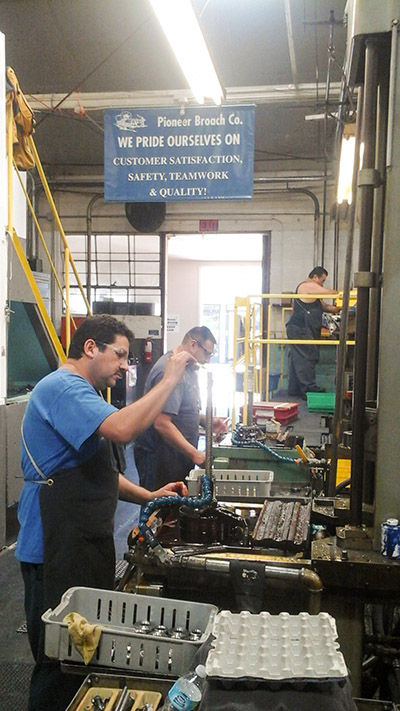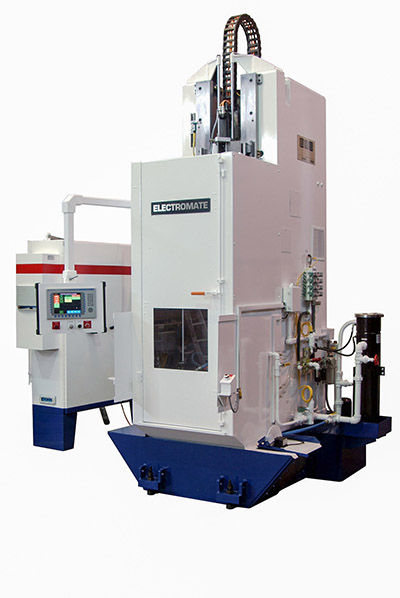“ There’s not much new going on
in broaching other than customers
asking that we hold tighter and
tighter tolerances. They’re thinking
that these are high-end CNC
machines but, of course, they’re
not. So if there’s anything new, it’s
that. Our challenge is always to be
more competitive with our tooling
and designing our tooling in different
ways to accommodate those
tighter tolerances.
“ [Broaching] is going to become
more cost effective as the younger
engineers coming out of college
are introduced to this method of
manufacturing and this method
of machining, and they see what it
can do. Right now they’re really not
taught anything about it. It’s considered
a blind art. Their instructors
kind of steer them away from
that and look for alternative method
of machining.
“ I think [broaching] is going to
expand. I think that as people
become more conscious of cost
and realize that we can hold tolerances
and move material faster
than any other method of machining
— nobody can move metal faster
than we can; we can move cubic
inches of material in a matter of
seconds — I think they’re going to
be more prone to accept it as a
viable method of manufacture for
their products.
“ As they learn that I think we’re
going to grow right along with
them.”
Bob Ezor, Vice President/General Manager — Pioneer Broach
Company (Los Angeles, CA)
“ There’s an art form to what we’re
doing. Ultimately, it’s ‘black magic.’
Yeah, it’s a machinist; it’s a grinding
process; it’s a production process;
but there is an art form to it.
“ We have master setup people who
are getting towards the end of
their career, so what do you do?
You get out your camera and you
get out your video and you get a
young engineer with him and you
document everything they’re doing
and how they’re doing it. It’s an art
form, and our toolmakers are artists
at what they’re doing.

- Click image to Enlarge
“ I’ve got jobs where 12 or 13 guys
try their hand at it and they can’t
do it. The guy who can do it
shows them, ‘put your hand
here, apply the right amount of
pressure, let it off right at that
spot,’ and so on and so forth. Good
guys — smart broach guys — nuhuh,
can’t do it. Then I see it and
I’m like, ‘How hard could it be? Let
me try that’ — no good. The master
gets back on there and he gets it,
because he’s got feel, he’s an artist
— not just anybody can do it.
“ You can write it down, you can
take pictures, you can even show a
guy, but there is an absolute skill
level to what we do. It’s just something
that if you don’t do it every
day — or even if you do do it every
day — you’re not going to be able
to do it like the masters, because
there’s a skill level to it.
Leon Agan, Project
Manager/Machine
Estimator — American Broach
and Machine (Ypsilanti, MI)
“ I think that the demise as a process
in high-volume production
was overestimated early on. I think
it’s going to be around for quite
a while, because there’s still no
faster way to cut high volumes of
parts. We’re probably going to go
towards dry broaching processes
more and more because coolant
disposal and contamination
becomes an issue. The only competition
for helical ring broaching is
skiving operations.
“ I think the trend is for hard
broaching after a spline is cut
into a part and goes through heat
treat, they want to go back and run
a carbide or some other type of
broach to recut the form to size. It’s
been around for quite a while but
people are starting to take note
(in the last two or three years)
that it’s necessary, especially with
the tighter tolerances required
by automakers and aerospace.
Basically, it’s overcoming heat treat
distortion, because you want to
broach up to no higher than 30 Rw
C. If you heat treat the parts and
get some sort of distortion, you
can go back and recut the spline to
the proper size.
“ I think the level of interest will
probably remain at about the level
it is now. I think the driving force is
just going to be the sales of automobiles
and heavy equipment. As
markets expand, more companies
are going to need to produce internal
splines and things like that.
“ The other trend is the move
towards electromechanically driven
machines, whether that’s ball
screws, roller screws or rack and
pinion, rather than the hydraulically
powered machines that are
tradition. However, we have found
that the hydraulic machines are
workhorses and last a long time.”
Jeffrey Frantz, Sales Manager — Ohio Broach & Machine
(Willoughby, OH)
“ Broaching really lends itself to
high-production. It really lends
itself from part to part. It can
hold very close tolerances. But
in that same token, the tooling
is very specific, the setups are
long and if your mode of manufacturing
is such that you run
large numbers of parts, you
can’t beat the broaching process.
But in today’s world we’re
faced with lean manufacturing
and they’re not setting up
to run large numbers of parts.
They want to run 400, 500
parts and then change over to
the next part. That is one reason
why people are hesitant
to go into broaching — because
the setups don’t allow you to
do that, basically.
“ Broaching is basically in two
different parts: You’ve got
surface broaching, where you
broach on the outside of a
part, and you’ve got internal
broaching , which is probably
the most traditional, where
you’re putting keyways and
splines inside of a hole.
“ Surface broaching is in a
world of hurt, because of the
lean manufacturing. That
end of broaching is kind of
dying. The internal broaching,
there’s still no better way
to put those forms into parts.
That state of broaching is still
going very well, and it’s where
our future lies.
“ In years past — 20 years or
more — organizations like
SME were very popular in
their meetings. Oftentimes, a
broach company would come
in and educate a company on
broaching. People just aren’t
attending those meetings anymore.
All external companies
are hurting. The young engineers
are basically all tuned
into the internet.
“ So how do I get onto the
internet and get the broaching
word out to these engineers
who have never heard of it or
haven’t learned it in school?
It’s a challenge, and I don’t
know if I have the answer
right now.”

- Click image to Enlarge
Ron Hehn, General Manager — Universal Broaching
(Elk Grove, IL)
“ The process has remained relatively the same since its
inception. There have been new developments from a tool
manufacturing standpoint, things like tighter tolerances
and holding the broach tools and things like that.
“ The thing is, they don’t really teach [broaching in schools]
anymore. It’s kind of a black art, to be honest. I think
[broaching] is a viable process and will continue to be a
viable process, but some people aren’t in-tune to it and are
looking at EDM and things like that. Don’t get me wrong,
it’s a great process, it’s just when you get into higher productions
it’s not a cost-effective method to produce certain
figures on parts.
“ I think there needs to be a little more emphasis on [broaching]
as a process for students going through some type of
manufacturing program. It’s such a specialized process and
that’s why not everybody does it. That’s kind of why there’s
just broaching companies, just like there’s people who do
just grinding, because that’s what they specialize in. It’s just
that grinding tends to be a little more commonplace than
broaching is.
“ When looking at the state of broaching, it’s really going
to be a reflection on a lot of the major industries, such as
automotive or heavy equipment and things like that, where
there are a lot of broach components that are used. A lot
of external surface broaching has gone down quite a bit
over the last 10, 15, 20 years, just with the advent of CNC
machines that have live tooling and things like that, where
flats or slots or things of that nature can be done right
on the same machine instead of a secondary machine like
broaching.
“ As far as internal shapes like keyways or splines or things
like that, there still isn’t a better cost effective method to
produce those types of features than broaching — especially
when you’re talking about production quantities or higher
volumes.
“ You’re not going to find a more effective way to do it.”
About Author
Erik Schmidt, Assistant Editor, has a Bachelor’s degree in journalism from Marquette University. He has a decorated writing history that includes stops at various journalistic enterprises in the Chicagoland area where he covered sports and hyperlocal news. He joined the staff of both Gear Technology and Power Transmission Engineering in 2014.










